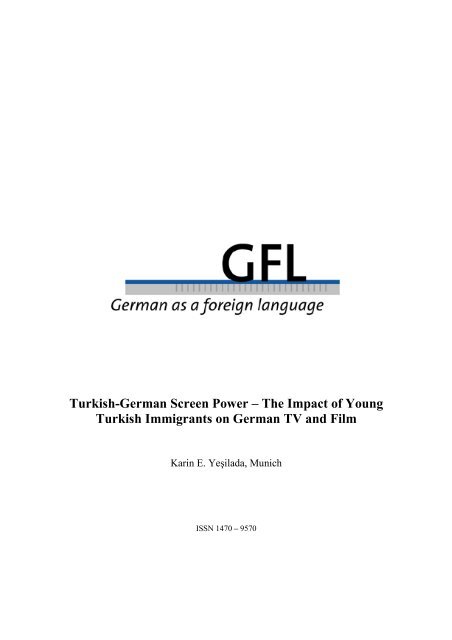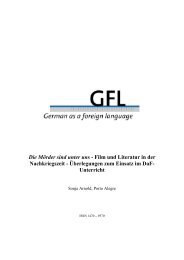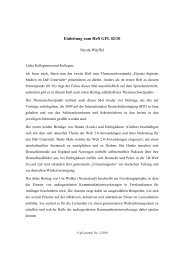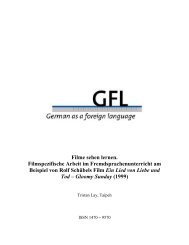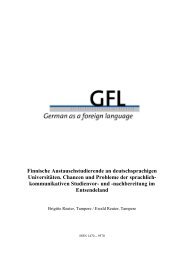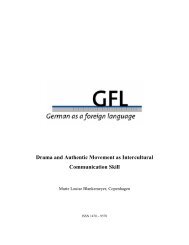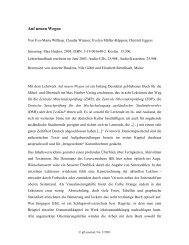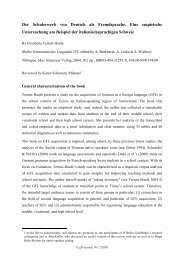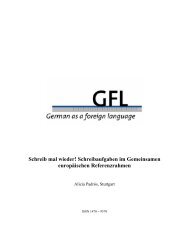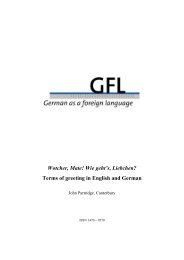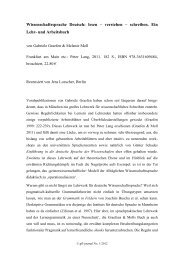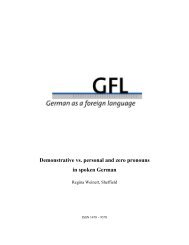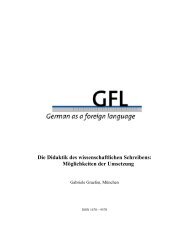Turkish-German Screen Power – The Impact of Young ... - GFL-Journal
Turkish-German Screen Power – The Impact of Young ... - GFL-Journal
Turkish-German Screen Power – The Impact of Young ... - GFL-Journal
Create successful ePaper yourself
Turn your PDF publications into a flip-book with our unique Google optimized e-Paper software.
<strong>Turkish</strong>-<strong>German</strong> <strong>Screen</strong> <strong>Power</strong> <strong>–</strong> <strong>The</strong> <strong>Impact</strong> <strong>of</strong> <strong>Young</strong><br />
<strong>Turkish</strong> Immigrants on <strong>German</strong> TV and Film<br />
Karin E. Yeşilada, Munich<br />
ISSN 1470 <strong>–</strong> 9570
<strong>Turkish</strong>-<strong>German</strong> <strong>Screen</strong> <strong>Power</strong><br />
<strong>Turkish</strong>-<strong>German</strong> <strong>Screen</strong> <strong>Power</strong> <strong>–</strong> <strong>The</strong> <strong>Impact</strong> <strong>of</strong> <strong>Young</strong> <strong>Turkish</strong><br />
Immigrants on <strong>German</strong> TV and Film<br />
Karin E. Yeşilada, Munich<br />
This article argues that with the emergence <strong>of</strong> a new generation <strong>of</strong> directors, screenwriters,<br />
actors and comedians, most <strong>of</strong> them <strong>Turkish</strong> born and having grown up in <strong>German</strong>y, <strong>Turkish</strong>-<br />
<strong>German</strong> film has undergone a fundamental transformation throughout the last decade.<br />
Inspired by European migrant film productions, filmmakers like Fatih Akın have contributed<br />
to a new tone in <strong>Turkish</strong>-<strong>German</strong> cinema. <strong>Turkish</strong> comedy also forms a new genre which has<br />
spread over to <strong>German</strong> television, where Kaya Yanar has successfully established ethnocomedy.<br />
Furthermore, new TV-series, like Türkisch für Anfänger, blend the <strong>Turkish</strong> and the<br />
<strong>German</strong> together in an exploration <strong>of</strong> the experiences <strong>of</strong> a patchwork-family. Meanwhile,<br />
<strong>German</strong> public broadcasting channels try to demonstrate a degree <strong>of</strong> normalization in the area<br />
<strong>of</strong> migrant experience, presenting new, positive image <strong>of</strong> the integrated migrant on screen.<br />
This article takes a closer look at what might be described as <strong>Turkish</strong>-<strong>German</strong> screenpower.<br />
1. <strong>The</strong> ‘<strong>Turkish</strong> Turn’ in <strong>German</strong> film-making<br />
In the decade since <strong>German</strong> unification, there has been a remarkable development in<br />
<strong>German</strong>-<strong>Turkish</strong> filmmaking. A new energy has spurred productions for cinema screen and<br />
television alike, and never before have there been so many <strong>Turkish</strong> names in the ranks <strong>of</strong><br />
directors, producers or actors. Two generations are at work in the filmmaking business:<br />
besides the first generation <strong>of</strong> directors who migrated to <strong>German</strong>y as young adults and<br />
started (or even continued) their artistic career in the new country, there is a second<br />
generation, the children <strong>of</strong> the immigrants. Having access to both <strong>German</strong> TV and cinema,<br />
as well as to <strong>Turkish</strong> films (via home video) and <strong>Turkish</strong> broadcasting channels (TRTint via<br />
cable and more recently all <strong>Turkish</strong> channels through satellite television), and later to an<br />
international TV schedule via satellite, as well as to international cinema, this generation’s<br />
media socialisation has been at least bi-cultural, if not transcultural. <strong>The</strong>se young <strong>Turkish</strong>-<br />
<strong>German</strong> filmmakers <strong>of</strong> the ‘next generation’ are creating a new <strong>German</strong> Cinema at the turn<br />
<strong>of</strong> the millennium.<br />
© gfl-journal, No. 1/2008<br />
73
Karin E. Yeşilada<br />
<strong>The</strong> ‘<strong>Turkish</strong> Turn’ in <strong>Turkish</strong>-<strong>German</strong> filmmaking 1 comes with a new way <strong>of</strong> telling<br />
stories, with new concepts <strong>of</strong> space and time, with increased speed, fast cutting, and with<br />
music drawn from contemporary subcultural scenes. Filmmakers <strong>of</strong> the generation born in<br />
the 1970s, like Fatih Akın, Kutluğ Ataman, Thomas Arslan, Ayşe Polat, and others, reflect<br />
their own cultural background in a far more relaxed way than the generation before them<br />
did. This certainly has to do with the simple fact that they, unlike their parents, grew up in<br />
the country where they started their pr<strong>of</strong>essional filmmaking career. For them, <strong>German</strong>y<br />
was no longer ‘40 square-metres’, but their country <strong>of</strong> origin. And even despite the<br />
increased xenophobia <strong>of</strong> the post-unification era, these young filmmakers make a point <strong>of</strong><br />
being <strong>German</strong> and <strong>Turkish</strong> at the same time. Yet in so doing, they do not operate with<br />
traditional binary oppositions, but with transcultural characters and storylines. 2<br />
Depicting Turks and <strong>German</strong>s not strictly apart from one another, but in intermeshed<br />
relationships, also lessens the burden <strong>of</strong> ‘purity’ that seemed to dominate earlier film<br />
productions. Deniz Göktürk (2000) judges the liminal effects <strong>of</strong> the <strong>German</strong>-<strong>Turkish</strong> traffic<br />
between the borders (‘Grenzverkehr’) to be a deliberate undermining <strong>of</strong> a supposed, ‘code<br />
<strong>of</strong> purity’ (‘Verstöße gegen das Reinheitsgebot’) for the representation <strong>of</strong> monolithic<br />
<strong>Turkish</strong> and <strong>German</strong> cultures. Petra Fachinger (2007: 244) identifies a ‘new energy that<br />
manifests itself in a new <strong>Turkish</strong>-<strong>German</strong> self-definition’ which no longer carries the<br />
burden <strong>of</strong> representing the ‘other’. This difference in perspective on <strong>Turkish</strong>ness in<br />
<strong>German</strong>y seems to come with the generational shift. <strong>The</strong> burden <strong>of</strong> defining oneself as the<br />
other in the sense <strong>of</strong> being a Turk versus the <strong>German</strong> seems to belong to the filmmaking <strong>of</strong><br />
the first generation. 3 In many films <strong>of</strong> the 1980s, hybridity is unknown and the worlds are<br />
neatly divided. Things <strong>German</strong> and <strong>Turkish</strong> are strictly apart in pre-unification film<br />
1 For the <strong>Turkish</strong> Turn in Contemporary <strong>German</strong> Literature, see Adelson (2005).<br />
2 Deniz Göktürk identifies a new point <strong>of</strong> view in movies like Berlin in Berlin (1993), where<br />
otherness suddenly refers to the <strong>German</strong>. Due to a dramatic plot, the <strong>German</strong> protagonist is forced<br />
to stay with a <strong>Turkish</strong> family in Berlin and thus becomes ‘the other’ who is being observed and<br />
even displayed to <strong>Turkish</strong> family members: this role reversal is at the core <strong>of</strong> the film’s ironical<br />
conception, as Göktürk states, and it is through this reversed perspective that the stereotypical view<br />
on Turks in <strong>German</strong> film is undermined (Göktürk 1998: 113 and 2000: 337-339).<br />
3 On <strong>Turkish</strong>-<strong>German</strong> filmmaking from the 1970s to the 1990s, see Göktürk’s articles. Tom<br />
Cheesman opposes the categorization by generation, suggesting that there are different strategies <strong>of</strong><br />
dealing with the “burden <strong>of</strong> representation” in the texts <strong>of</strong> <strong>Turkish</strong> authors (Cheesman 2006). As to<br />
<strong>Turkish</strong>-<strong>German</strong> film, the generational differentiation seems to remain important.<br />
© gfl-journal, No. 1/2008<br />
74
<strong>Turkish</strong>-<strong>German</strong> <strong>Screen</strong> <strong>Power</strong><br />
productions. While Göktürk holds the peculiarities <strong>of</strong> the <strong>German</strong> funding system<br />
responsible for a certain tendency to restrict the migrant figure to a life between cultures in<br />
a ‘cinema <strong>of</strong> duty’ (Göktürk 2000: 333), not all critics agree with this view, even though an<br />
anthology <strong>of</strong> the mid 1990s refers to the uneven, distorted representation <strong>of</strong> foreigners in<br />
<strong>German</strong> film as ‘getürkte Bilder’ (Karpff et. al. 1995). Guido Rings (2008) suggests that, in<br />
contrast, there has been a shift in the representation <strong>of</strong> boundaries in migrant cinema after<br />
unification that takes the form <strong>of</strong> politically incorrect satire and a clear marginalisation <strong>of</strong><br />
the themes <strong>of</strong> xenophobia and racism. Clear-cut cultural boundaries have been gradually<br />
blurred, and the former guest worker figure substituted by protagonists with transnational<br />
features (cf. Rings in this volume).<br />
Figures like Fatih Akın’s protagonists Nejat in Auf der anderen Seite (2007) or Sibel in<br />
Gegen die Wand (2005) are typical examples <strong>of</strong> the transcultural character <strong>of</strong> the new<br />
<strong>German</strong> cinema made by <strong>Turkish</strong>-<strong>German</strong> filmmakers. Both Nejat and Sibel are second-<br />
generation Turks in <strong>German</strong>y, both move from <strong>German</strong>y to Turkey in order to try out<br />
another option in life. Both are able to live in either country and shift from one place to the<br />
other for good without major problems, and even their <strong>Turkish</strong>, however rudimentary,<br />
suffices for a new start. <strong>The</strong> main conflicts come with personal rather than with cultural<br />
affairs, as both figures rebel against their fathers, and even if both figures end up in Turkey<br />
leading almost exactly the kind <strong>of</strong> life their fathers had planned for them, it is the<br />
availability <strong>of</strong> both possibilities, <strong>of</strong> a life here or there that marks the difference.<br />
Almost all <strong>of</strong> Akın’s films are situated in more than one country, but this does not mean<br />
that a transnational topography dominates the film. Whether the movie tells a love story<br />
that has the lovers loose and find one another in a journey across <strong>German</strong>y, the Balkans,<br />
and finally Turkey (as in the road movie Im Juli, 2000), or a story <strong>of</strong> brotherly rivalry set in<br />
<strong>German</strong>y and Italy (Solino, 2002), or the dramatic story <strong>of</strong> a rebellion and an amour fou in<br />
<strong>German</strong>y and Turkey (Gegen die Wand, 2004), or a story <strong>of</strong> finding, loosing and searching<br />
for a friend or a father (as in Auf der anderen Seite, 2007) <strong>–</strong> each tale is situated in a<br />
transcultural setting. Yet, whether the figures live out their experiences in <strong>German</strong>y or<br />
abroad does not really change the storyline. Living here or there is a possibility the figures<br />
try out. When Nejat resigns from his job at the <strong>German</strong> department in Hamburg only to<br />
take over a <strong>German</strong> bookshop in Istanbul, he represents the flexibility <strong>of</strong> a transcultural<br />
© gfl-journal, No. 1/2008<br />
75
Karin E. Yeşilada<br />
generation ready to move from one country to another, knowing that there is a job-<br />
opportunity on either side.<br />
For Fatih Akın’s generation, shifting between <strong>German</strong>y and Turkey has become much<br />
easier than it had been for their parents twenty, thirty years ago. 4 In his movies, it is simply<br />
a matter <strong>of</strong> taking a plane or a car. Because the transnational boundaries are easily<br />
overcome, the movie can tell other stories <strong>of</strong> a universal character: the loss <strong>of</strong> a beloved, the<br />
search for love. Referring to places, persons or models beyond his direct environment<br />
comes naturally in Fatih Akın’s transcultural work, and this habit <strong>of</strong> ‘crossing the bridge’<br />
makes him a transcultural artist par excellence. 5 His artistic and financial involvement in<br />
transnational <strong>German</strong>-<strong>Turkish</strong> co-productions is having an increasing impact on <strong>Turkish</strong><br />
cinema too (Farzanefar 2007). Akın’s international success sheds light on the new <strong>Turkish</strong>-<br />
<strong>German</strong> cinema as part <strong>of</strong> the (new) ‘New <strong>German</strong> Cinema’ that has been hailed as an<br />
outbreak from the ghetto at the end <strong>of</strong> the 1990s (Göktürk 2000). 6<br />
4 This does not, however, indicate an insuperable generation gap. In contrast to Alain Bergala, who<br />
observes precisely this phenomenon in French cinema (Bergala: 61), the contemporary productions<br />
<strong>of</strong> <strong>German</strong>-<strong>Turkish</strong> cinema and TV are full <strong>of</strong> sometimes ironic intermedial references to film and<br />
literature <strong>of</strong> the first and second generation. Although this referencing has not yet resulted in the<br />
filming <strong>of</strong> a novel (as Tevfik Başer did when he adapted Saliha Scheinhardt’s novel for his<br />
Abschied vom falschen Paradies, 1988), quotations are distinct. In Fatih Akın’s Auf der anderen<br />
Seite, Selim Özdoğans novel Die Tochter des Schmieds (2005) plays a role in the father-sonrelationship,<br />
and the novel is explicitly mentioned in the credits. In earlier films, Akın also alluded<br />
to authors <strong>of</strong> the generation before him, like Güney Dal and Adalet Ağaoğlu, once again bridging<br />
generational worlds.<br />
5 Tom Cheesman (2007) has coined the term cosmopolite.<br />
6 According to Göktürk (2000), the breakthrough <strong>of</strong> a so-called ‘New <strong>German</strong> Cinema’ (meaning<br />
the ‘next’ new <strong>German</strong>, i.e. multicultural <strong>German</strong> cinema, cf. Göktürk 2000:239) came with a new<br />
generation <strong>of</strong> filmmakers <strong>of</strong> non-<strong>German</strong>, particularly <strong>Turkish</strong> origin, who presented their films in<br />
the ‘New <strong>German</strong> Cinema’ category at the Berlin Film Festival in February 1999, together with<br />
many new transnational film productions. Among those young filmmakers were Thomas Arslan<br />
(Dealer), Kutluğ Ataman (Lola and Bilidikid) and Fatih Akın (Kurz und schmerzlos), whose films,<br />
though very individual, still had several things in common. None <strong>of</strong> them told a ‘tale <strong>of</strong> poor<br />
guestworkers’, nor the story <strong>of</strong> how ‘Leyla gets liberated by Hans’. Each <strong>of</strong> them dealt, rather, with<br />
themes <strong>of</strong> modern urban life instead, i. e. the existence <strong>of</strong> a drug dealer between legality and crime<br />
in Berlin (Arslan), insights into the Berlin transvestite scene (Ataman), or a classical gangster-story<br />
situated in Hamburg. All three films depict the <strong>Turkish</strong> figure as a ‘Großstadt-Cowboy’ (Sterneborg<br />
1999), and the urban space (Berlin, Hamburg) as the setting and a major element <strong>of</strong> the<br />
‘Großstadterzählung’, a tale <strong>of</strong> the city rather than <strong>of</strong> its inhabitants (Vogt 2000). Showing at the<br />
same festival were productions with regional support like the trilingual melodrama Aprilkinder<br />
(1998) by Yüksel Yavuz, or Kanak Attack (1998), Lars Becker’s adaptation <strong>of</strong> Feridun Zaimoğlu’s<br />
tale <strong>of</strong> a young <strong>Turkish</strong> drug dealer, and Hussi Kutlucan’s Ich Chef, Du Turnschuh (1998).<br />
© gfl-journal, No. 1/2008<br />
76
<strong>Turkish</strong>-<strong>German</strong> <strong>Screen</strong> <strong>Power</strong><br />
<strong>The</strong> <strong>Turkish</strong> Turn in filmmaking produced films that dealt with this generation, a<br />
generation on the move, taking things with a good deal <strong>of</strong> irony and humour. European and<br />
particularly British film productions with ironical, multicultural stories, like East is East or<br />
Bend it like Beckham, as well as productions without explicit migrant contexts like<br />
Trainspotting or <strong>The</strong> Commitments, depicting contemporary society both realistically and<br />
humorously, may have influenced the <strong>German</strong>(-<strong>Turkish</strong>) film scene as well. It now seemed<br />
possible to think <strong>of</strong> <strong>Turkish</strong>-<strong>German</strong> film productions that had <strong>Turkish</strong> or Greek<br />
protagonists without necessarily telling migrant tales. In this way, the ‘New <strong>German</strong><br />
(<strong>Turkish</strong>) Cinema’ <strong>of</strong>fers a fresh view on cultural matters.<br />
2. ‘<strong>Turkish</strong> light’ <strong>–</strong> A New Genre<br />
If transculturalism is the main characteristic <strong>of</strong> the new <strong>Turkish</strong>-<strong>German</strong> cinema, another<br />
key feature <strong>of</strong> the movies from the late 1990s onwards is the role <strong>of</strong> humour. This concerns<br />
productions for cinema and television alike, and connects to other contexts too, e. g. the<br />
East-West-<strong>German</strong> in productions like Goodbye, Lenin!, where reviving the GDR inside a<br />
home serves as an ironical comment on the political context <strong>of</strong> <strong>German</strong> unification and the<br />
ongoing nostalgia for the former GDR. Likewise, directors like Akın or Kutlucan use irony<br />
as an instrument to convey their critique <strong>of</strong> discriminatory relations between <strong>German</strong>s and<br />
non-<strong>German</strong>s. While they critically ridicule certain aspects <strong>of</strong> minority affairs, more recent<br />
productions renounce the subtlety <strong>of</strong> irony in favour <strong>of</strong> the grotesque. This new genre could<br />
be subsumed under the name ‘<strong>Turkish</strong> light’ (‘light’ or ‘lite’, meaning light-weight):<br />
<strong>Turkish</strong>-<strong>German</strong> co-productions aiming at a multicultural mass-audience who want to have<br />
a good laugh at the confusions <strong>of</strong> multiculturalism.<br />
Kebab Connection (2005) is an example <strong>of</strong> this new humour in <strong>Turkish</strong>-<strong>German</strong> film. Ibo,<br />
a young <strong>German</strong> Turk, dreams <strong>of</strong> producing the first <strong>German</strong> Kung-Fu-movie ever, but gets<br />
into trouble with his family and <strong>German</strong> girlfriend instead. This comedy, starring a brilliant<br />
Denis Moschitto as newcomer in a mostly migrant cast, referenced the style <strong>of</strong><br />
advertisements and Kung-Fu films, as well as the speed <strong>of</strong> the new comedy genre. Written<br />
by Fatih Akın and Ruth Thoma, co-produced by Akın’s Wüste Filmproduction,<br />
© gfl-journal, No. 1/2008<br />
77
Karin E. Yeşilada<br />
Westdeutscher Rundfunk (WDR) and Arte, Kebab Connection became the summer hit <strong>of</strong><br />
2005. A year earlier, Süperseks had worked on a similar pattern, telling the story <strong>of</strong> young<br />
<strong>Turkish</strong> Elviz (also starring Denis Moschitto) who, because <strong>of</strong> financial problems, starts the<br />
first <strong>Turkish</strong>-language sex-hotline in Hamburg. Since employees and clients all belong to<br />
the same <strong>Turkish</strong> community and after a while begin to recognize each other, comical<br />
chaos ensues. This film, too, was a co-production <strong>of</strong> private and public service institutions,<br />
including Studio Babelsberg Motion Pictures, Zweites Deutsches Fernsehen (ZDF) and<br />
Arte. Both films set their stories in a multicultural (mostly <strong>German</strong>-<strong>Turkish</strong>) milieu, operate<br />
with the plot device <strong>of</strong> a young, attractive hero getting into trouble and solving the problem<br />
in a creative, rather unconventional way, thereby creating comical chaos with a happy<br />
ending. And both productions present the migrant milieu as one <strong>of</strong> tradition and taboo,<br />
invention and creativity, chaos and comedy at the same time. <strong>The</strong>y gain lightness through<br />
their fast pace and general tongue-in-cheek tone, and they pr<strong>of</strong>it from a remarkable range <strong>of</strong><br />
(young) actors <strong>of</strong> <strong>Turkish</strong> or multicultural descent (like Denis Moschitto, Hilmi Sözer,<br />
Tayfun Bademsoy, Adnan Maral, Adam Bousdoukos, and many others). <strong>The</strong>y are<br />
reminiscent <strong>of</strong> productions like East is East.<br />
Interestingly, this ‘<strong>Turkish</strong> light’ genre emerges at the same time as <strong>German</strong> public debates<br />
over the supposed ‘failure <strong>of</strong> <strong>Turkish</strong> integration and the existence <strong>of</strong> a <strong>Turkish</strong> (Islamic)<br />
“parallel society” that ‘threatens’ <strong>German</strong> society with orthodox religious views, rigid<br />
traditionalism, domestic violence, and honour killings. According to this debate, which is<br />
lead by major institutions <strong>of</strong> the <strong>German</strong> media, the concept <strong>of</strong> multiculturalism has<br />
‘failed’. <strong>Turkish</strong> feminist rights activists like Seyran Ateş or sociologists like Necla Kelek<br />
accuse <strong>Turkish</strong> men <strong>of</strong> threatening the liberalism <strong>of</strong> <strong>German</strong> society with their violent<br />
orthodoxy <strong>–</strong> a view that is not, however, shared by all critics (Cheesmann 2007: 114f). Still,<br />
the debate has renewed old stereotypes <strong>of</strong> the violent <strong>Turkish</strong>-Muslim enemy, not least<br />
through countless pseudo-objective ‘documentaries’, which constantly present the same<br />
topics from the problem area: Islam (terrorism, menace), the women’s question<br />
(headscarves), patriarchy (honour killings, forced marriages), social problems<br />
(unemployment, criminality), <strong>of</strong>ten confusing information with cliché. <strong>The</strong> tendency to<br />
construct an image <strong>of</strong> the ‘problematic Turk’ in the media has increased since the terror<br />
© gfl-journal, No. 1/2008<br />
78
<strong>Turkish</strong>-<strong>German</strong> <strong>Screen</strong> <strong>Power</strong><br />
acts <strong>of</strong> 9/11. Media and politics have continually depicted <strong>Turkish</strong> immigrants as part <strong>of</strong> the<br />
Islamic menace to western society ever since (Butterwegge 2007).<br />
On the other hand, probably in reaction to this negative trend, the public broadcasting<br />
services have tried more recently to pay tribute to (<strong>Turkish</strong>) immigration to <strong>German</strong>y. <strong>The</strong><br />
aim is to establish a positive picture <strong>of</strong> the integrated migrant through TV (Buettner 2007).<br />
In a recent and new turn in <strong>German</strong> television, the notion <strong>of</strong> ‘Integration im TV’ not only<br />
calls for an increased representation <strong>of</strong> migrants on and behind the screen (i. e. presenters,<br />
hosts, actors, scriptwriters, directors), but also opens the door to <strong>Turkish</strong> themes in the<br />
fictional realm. This is how two productions <strong>of</strong> the ‘<strong>Turkish</strong> light’ genre for <strong>German</strong><br />
television came about, and it is interesting to see how they deal with the task <strong>of</strong> depicting<br />
<strong>Turkish</strong> migrant life in <strong>German</strong>y.<br />
Meine verrückte türkische Hochzeit (2006) clearly leaned on the US-American box-<strong>of</strong>fice<br />
hit My Big Fat Greek Wedding in telling the tale <strong>of</strong> an intercultural romance. Here, it is a<br />
<strong>Turkish</strong>-<strong>German</strong> wedding project that has to overcome all possible difficulties associated<br />
with cross-cultural relationships. Yet, even though this production <strong>of</strong> private channel Pro<br />
Sieben was nominated for the <strong>German</strong> TV Award (Deutscher Fernsehpreis) in 2006, and<br />
won several awards (Grimme-Preis, Bayerischer Fernsehpreis) a year later, the romantic<br />
comedy is marred by the way it depicts <strong>Turkish</strong> figures, trying to incorporate all possible<br />
examples <strong>of</strong> the ‘typical’ Turk, including an irascible <strong>Turkish</strong> father, a menacing brother, a<br />
religious sister and several <strong>Turkish</strong>-run grocery shops. Presenting the whole range <strong>of</strong><br />
clichés that mark the distorted view <strong>of</strong> <strong>Turkish</strong> migrants, it thereby continues the tradition<br />
<strong>of</strong> ‘getürkte Bilder’ in <strong>German</strong> film (Karpff et al 1995). On the whole, the film does not<br />
keep its promise <strong>of</strong> being hilarious or even crazy (‘verrückt’), mainly because it cannot<br />
decide whether to be ironic or not.<br />
<strong>The</strong> same goes for Zeit der Wünsche (2005), another ambitious TV-production for the<br />
public service channel ARD, the saga <strong>of</strong> <strong>Turkish</strong> migration to <strong>German</strong>y. In two parts, the<br />
story unfolds <strong>of</strong> the life <strong>of</strong> three Anatolian friends who all go to <strong>German</strong>y as migrants.<br />
While their experience <strong>of</strong> being guestworkers fulfils their existential expectations, their<br />
general happiness is undermined by a fatal love-and-betrayal conflict. Heroine Melike<br />
escapes from a forced marriage to temporary freedom in <strong>German</strong>y, but is finally shot by her<br />
© gfl-journal, No. 1/2008<br />
79
Karin E. Yeşilada<br />
ex-husband, who comes from Anatolia to carry out an ‘honour killing' on <strong>German</strong> soil.<br />
Developing the storyline towards this tragic ending marred this TV double-feature on<br />
<strong>German</strong>y’s Turks. This might have been due to the scriptwriter's provenance, 7 or even, to<br />
argue with Göktürk, to the fact that this production pr<strong>of</strong>ited from public film funding, thus<br />
aiming it at a mostly <strong>German</strong> TV-audience. Trying to tell tales <strong>of</strong> Turks by means <strong>of</strong> a<br />
multicultural cast also affected the language: while the two previously mentioned cinema<br />
productions used their mixed cast without indicating language changes, the TV productions<br />
made a point <strong>of</strong> using the <strong>Turkish</strong> accent. By means <strong>of</strong> a distorted <strong>German</strong>, it is made clear<br />
to the audience that guestworkers struggle at least with language, if not with <strong>German</strong><br />
culture as a whole <strong>–</strong> language already marks the Turk as different on <strong>German</strong> TV. Overall,<br />
the sentimental saga reconnected in unfortunate fashion to the tradition <strong>of</strong> the 1980s<br />
migrant ‘cinema <strong>of</strong> duty’, as well as contributing to the ongoing public debate on ‘<strong>Turkish</strong><br />
incompatibility’. Moreover, via its melodramatic finale, it also confirmed the prevalent<br />
notion <strong>of</strong> the ‘failed integration’ <strong>of</strong> <strong>German</strong>y’s Turks.<br />
Zeit der Wünsche reached a wide audience through television. 8 <strong>The</strong> thoroughly positive<br />
reaction to it might be explained with reference to what postcolonial theory has called<br />
‘history written from the margins into the centre’: at last the story <strong>of</strong> <strong>German</strong> immigration, 9<br />
or more specifically, the story <strong>of</strong> the <strong>Turkish</strong> migration to <strong>German</strong>y, had been <strong>of</strong>ficially<br />
acknowledged by <strong>German</strong> TV and the entertainment industry. Zeit der Wünsche had<br />
successfully turned the story <strong>of</strong> <strong>Turkish</strong> migrants into an evening’s worth <strong>of</strong> story on<br />
screen, however questionable the picture <strong>of</strong> the migrant it conveyed in the process. 10<br />
7<br />
<strong>Turkish</strong> film veteran Tevfik Başer (*1951) continued his already established dramatic approach to<br />
the subject. <strong>The</strong> melodramatic ending, with the heroine getting shot in the middle <strong>of</strong> the street, is<br />
also reminiscent <strong>of</strong> the 1980s <strong>Turkish</strong> Yeşilçam Cinema.<br />
8<br />
<strong>The</strong> DVDs were later supplemented with <strong>Turkish</strong> dubbing or subtitles for the migrant audiences,<br />
much to the delight <strong>of</strong> <strong>Turkish</strong> viewers (cf. consumer comments on http://www.amazon.de).<br />
9<br />
<strong>The</strong> story <strong>of</strong> the <strong>German</strong> Republic has recently been re-interpreted as a story <strong>of</strong> immigration, see<br />
Motte (1999).<br />
10<br />
See Cheesman’s reflections on the similar effects <strong>of</strong> Necla Kelek's work (2007: 117).<br />
© gfl-journal, No. 1/2008<br />
80
2.1 Ethno-Comedy<br />
<strong>Turkish</strong>-<strong>German</strong> <strong>Screen</strong> <strong>Power</strong><br />
Whether a production like Zeit der Wünsche still belongs to the ‘light’ genre, remains open<br />
to debate. In general, though, the taste for comedy is spreading from cinema to TV.<br />
Comedians like Kaya Yanar entertain the audience with what has been newly established as<br />
a <strong>Turkish</strong> brand <strong>of</strong> ethno-comedy. Kaya Yanar, born in 1973, the son <strong>of</strong> a <strong>Turkish</strong> mother<br />
and an Arabic father, started as a stand-up comedian while still a student. His popular<br />
comedy-show Was guckst du?! on private channel SAT1 ran from 2001 to 2005 for five<br />
seasons. Yanar presented many ethno-gags and incorporated different ethnic types, e. g. a<br />
first-generation <strong>Turkish</strong> migrant with moustache and pre-modern views (Yildirim), an<br />
Italian gigolo (Francesco), a Polish criminal, and many others. Among those, the Indian<br />
(Ranjid, a clever-naive figure played by Yanar with a lot <strong>of</strong> brown make-up and a<br />
permanently smiling face, old-fashioned jumpers and a great Indian accent) and the <strong>Turkish</strong><br />
Macho (Hakan, disco doorman with little brain but a line that became a classic: ‘Ey, du<br />
kommst hier ned rein!’) became the audience’s favourites. Excerpts from foreign language<br />
TV-programmes (with comic effects <strong>of</strong>ten resulting from comical culture-clashes), witty<br />
sketches, corny and risqué jokes all added up to fulfil the prime aim <strong>of</strong> his show, i. e. to<br />
base comedy on ethnicity, and to have fun. Similar to Sascha Baron Cohen’s principle <strong>of</strong><br />
adopting pseudo-ethnic identities, e. g. his character Ali G., which may well have been an<br />
inspiration for Yanar, ethno-comedy worked on the comical side-effects <strong>of</strong> minority<br />
cultures: a funny accent (Ranjid), comical appearance (Hakan), machismo gone wrong<br />
(Francesco), etc., with politically incorrect jokes about ‘the other’ <strong>–</strong> nothing less than a<br />
perfect example <strong>of</strong> mimicry.<br />
So why does this taste for a laugh about ethnicity work so well without being tasteless?<br />
Doesn’t Yanar confirm the stereotypes, rather than question them? Thanks to his<br />
remarkable comic talent, this stereotyping can be understood as being itself a parody. <strong>The</strong><br />
primary effect comes from the first principle <strong>of</strong> ethno-comedy which is that the ‘native<br />
ethno’ can tell jokes which ‘native <strong>German</strong>s’ would never dare to tell in public. So, if<br />
‘political correctness’ is guaranteed by the fact that Yanar himself has a minority<br />
background, then his ethno-comedy works as a perfect mimicry. On the other hand, the<br />
genre itself defines the humour as a harmless means <strong>of</strong> entertainment, rather than as a<br />
© gfl-journal, No. 1/2008<br />
81
Karin E. Yeşilada<br />
means to criticise and educate the audience. Unlike satire, comedy does not primarily<br />
intend to attack social evils, but rather distract from them. 11 While <strong>Turkish</strong>-<strong>German</strong> satire 12<br />
presents ‘typical Turks’ or ‘typical <strong>German</strong>s’ to grotesque effect not just for the sake <strong>of</strong><br />
comedy but also for more political purposes (e. g. by presenting the ‘over-integrated Turk’<br />
as a victim <strong>of</strong> <strong>of</strong>ficial <strong>German</strong> integration policies), <strong>Turkish</strong> ethno-comedy happily indulges<br />
in the joke, just for the sake <strong>of</strong> a good laugh. <strong>The</strong> message here is to entertain and to have<br />
fun. 13<br />
In keeping with the principles <strong>of</strong> comedy, Kaya Yanar is at the centre <strong>of</strong> the comedy<br />
show.<strong>The</strong> ease with which he deals with issues <strong>of</strong> identity is typical <strong>of</strong> his generation. In<br />
the biographical notes on his homepage, Yanar refers to an untroubled, cosmopolitan<br />
childhood growing up in the multicultural environment <strong>of</strong> Frankfurt, where being different<br />
was ‘interesting’ rather than problematic. 14 This again aligns him with his audience, many<br />
<strong>of</strong> whom are young migrants who identify with him, as well as young to middle age<br />
<strong>German</strong>s who join in the fun. Yanar’s famous slogan ‘Was guckst du?!, half-mocking the<br />
migrants' linguistic deficiencies, half representing their readiness to defend themselves (the<br />
‘what's up?’ <strong>of</strong> young Kanaks), has become a cult phrase. So, Kaya Yanar’s embodiment <strong>of</strong><br />
the light-hearted, permanently joking <strong>Turkish</strong>-<strong>German</strong> comedian from the younger<br />
generation could be regarded as resulting as much from the breakthrough <strong>of</strong> the second<br />
generation into film and literature, as from private television companies ‘going ethnic’ in<br />
the 1990s.<br />
But the broader context <strong>of</strong> this phenomenon is the privatization <strong>of</strong> <strong>German</strong> TV and the rise<br />
<strong>of</strong> comedy shows on private channels such as SAT and RTL, a development, which,<br />
according to some critics, has ‘dramatically’ changed <strong>German</strong> attitudes towards humour<br />
(‘Lachverhalten’, as Kammertöns 2007 puts it). <strong>The</strong> new genre calls for new skills, and<br />
consequently, comedians appear to be the newly skilled ‘Lacharbeiter’ (Kammertöns puns<br />
11<br />
For a general distinction, see Wellstein (2007) and Reinhard (2006).<br />
12<br />
On <strong>Turkish</strong>-<strong>German</strong> satire and its most prominent authors, Şinasi Dikmen and Osman Engin, see<br />
Terkessidis (2000) and Yeşilada, (2000).<br />
13<br />
Yanar insists on having pursued his career independently from any ethnic boom (‘ich bin kein<br />
Produkt des Aufbruchs der türkischen community’), nor did he embody the burden <strong>of</strong> a <strong>Turkish</strong><br />
identity (‘...ich war einfach nur Künstler, der auf dieBühne geht’). Cited in Lemke-Matwey et.al.<br />
(2003); see also Kaiser (2001).<br />
© gfl-journal, No. 1/2008<br />
82
<strong>Turkish</strong>-<strong>German</strong> <strong>Screen</strong> <strong>Power</strong><br />
on the <strong>German</strong> term ‘Facharbeiter’, here). In fact, Yanar belongs to the generation <strong>of</strong> so-<br />
called ‘self-made comedians’ who entered commercial television from the late 1990s<br />
onwards, including comedians like Atze Schröder, Oliver Pocher, Rick Kavanian, the<br />
famous Kanak-duo Erkan & Stefan, 15 and many others. Together they make up the on-<br />
screen part <strong>of</strong> a larger boom in ethno-cabaret and stand-up comedy amongst the 1970s<br />
generation. <strong>The</strong> ethno-comedians among them in particular had the chance to introduce<br />
their audiences to minority issues. But the fact that they wasted this chance for the sake <strong>of</strong><br />
comedy ‘light’ was exactly what disappointed many critics, among them Feridun Zaimoğlu,<br />
one <strong>of</strong> the leaders <strong>of</strong> the rebellious young Turks <strong>of</strong> the 1990s. 16<br />
It is characteristic <strong>of</strong> the TV-comedy genre that it shares some <strong>of</strong> its impact with the<br />
cabaret, and not surprisingly, <strong>Turkish</strong> ethno-comedy and <strong>Turkish</strong>-<strong>German</strong> cabaret have a<br />
lot in common. <strong>Turkish</strong>-<strong>German</strong> cabaret had long been successful in <strong>German</strong>y. Leading<br />
artists Şinasi Dikmen and Muhsin Omurca toured throughout <strong>German</strong>y with their Knobi<br />
Bonbon cabaret for over a decade in pre- and post-unification <strong>German</strong>y, presenting<br />
<strong>Turkish</strong>-<strong>German</strong> political cabaret at its best. After their separation, both artists continued<br />
with similarly satirical solo performances. Taking up the tradition <strong>of</strong> political satire from<br />
Dieter Hildebrandt’s satirical TV-programme Scheibenwischer, Django Asül (*1972)<br />
presents straight political cabaret too. 17 Serdar Somuncu (*1968) went on tour from 1996<br />
14 See http://www.yanar.de.<br />
15 Ironically, the most popular ‘ethno-comedians’ in this field are <strong>of</strong> (native) <strong>German</strong> origin: Erkan<br />
& Stefan, alias Erkan Maria Moosleitner and Stefan Lust, became widely known as ‘typical<br />
Kanaken’ through radio and several film productions. Embodied by two ‘native Bavarians’ born in<br />
1971, John Friedman and Florian Simbeck, they had enormous success with their parody <strong>of</strong> ‘Kanak<br />
Sprak’, coining words like ‘krass’ or ‘brontal’ in a vernacular that was believed to be the typical<br />
‘Kanakendeutsch’ <strong>of</strong> <strong>Turkish</strong> migrants. In this way, Erkan & Stefan in the roles <strong>of</strong> a <strong>German</strong>-Turk<br />
and his <strong>German</strong> buddy, made the supposed streetlife <strong>of</strong> young Turks/migrants popular and<br />
acceptable despite the mimicry. Having started at small venues in 1994, the successful duo decided<br />
to put an end to their characters’ existence, after more than three movies and countless apperances<br />
and media productions, in order to start serious acting in 2007.<br />
16 Zaimoğlu attacked his comedy colleagues in an article, rebuking them for being merely the<br />
purveyors <strong>of</strong> cheap jokes for a willing audience (‘Der “Isch-hau-disch”-Zahnlücken-Irrwitz<br />
schäumte auf einer großen Sympathiewoge’), and challenged them to improve the quality <strong>of</strong> their<br />
comedy. Zaimoğlu (2003).<br />
17 This temporarily made him the famous ‘Bruder Barnabas’ <strong>of</strong> the annual Paulaner Brewers<br />
Political Satire Event (Starkbieranstich auf dem Nockherberg) in Munich 2007, a role which Asül<br />
immediately lost in suspicious circumstances right after his ferocius debut. Christian Mayer refers<br />
to unquoted politicians who had protested against the sharp, witty criticism <strong>–</strong> a critique which they<br />
© gfl-journal, No. 1/2008<br />
83
Karin E. Yeşilada<br />
until 2001 with a reading from Adolf Hitler’s ‘Mein Kampf’, and later with declamations <strong>of</strong><br />
Joseph Goebbels’ famous 1943 war speech. 18 Yet, Somuncu, Asül, Dikmen and Omurca<br />
belong to a minority <strong>of</strong> artists representing classical political satire, while the mainstream<br />
opts for the light version <strong>of</strong> just comedy.<br />
Most <strong>Turkish</strong> stand-up comedians, like Fatih Cevikkollu, Bülent Ceylan, or Murat Topal,<br />
earn their laughs engaging in the intercultural opposition <strong>of</strong> ‘Turks and (or versus)<br />
<strong>German</strong>s’. Knowing what life as part <strong>of</strong> a minority in <strong>German</strong>y is about, Cevikkollu jokes<br />
about being mistaken for a member <strong>of</strong> the Taliban, Bülent Ceylan reflects on what <strong>German</strong>s<br />
think <strong>of</strong> a typical Turk, and Murat Topal draws from his experience as a real life police<br />
<strong>of</strong>ficer. Embedding their cross-cultural criticism in generally ‘light’ humour, however,<br />
unlike their colleagues from political cabaret, they embrace their audience rather than<br />
provoking them. Through television, these comedians get more attention than via their<br />
usual stand-up acts. 19 <strong>The</strong> native <strong>German</strong> audience, on the other hand, has got to know<br />
<strong>Turkish</strong> ethno-comedy much better than they did a decade ago. <strong>The</strong> popularity <strong>of</strong> light-<br />
hearted TV-comedy helps to create a bond between the artist and the audience, and with<br />
ethno-comedy, this is even more the case, as laughing about the others (here: the Turks) is<br />
possible through laughing with them. So, the integration <strong>of</strong> migrant comedians into the vast<br />
humour market on <strong>German</strong> private TV is a success, after all <strong>–</strong> however ‘light’ the critical<br />
potential.<br />
3. <strong>The</strong> <strong>Turkish</strong> Turn in TV-series<br />
With the expansion <strong>of</strong> the private TV-sector in <strong>German</strong>y and the ever rising demand for<br />
TV-programme material, US-sitcoms have gained an increasing impact, not only by their<br />
mere presence, but also as role models for similar <strong>German</strong> productions. Claudia Holzer<br />
were not prepared to accept from a <strong>Turkish</strong>-Bavarian artist. Cf. Süddeutsche Zeitung, 3 August<br />
2007 (‘Ich hätte gerne weitergemacht’).<br />
18 Almost all artists have websites on which they display their programmes and other information;<br />
cf. http://www.die-kaes.com for Dikmen, http://www.omurca.de for Omurca; see also:<br />
http://www.django-asuel.de and http://www.somuncu.de.<br />
19 Cevikollu, Ceylan and Topal appeared in a TV-special on <strong>Turkish</strong> comedy (Deutsch-Türkisch,<br />
Türkisch Deutsch) broadcast nationwide and hosted by Django Asül in 2007.<br />
© gfl-journal, No. 1/2008<br />
84
<strong>Turkish</strong>-<strong>German</strong> <strong>Screen</strong> <strong>Power</strong><br />
(1999) argues that it took a long time to establish <strong>German</strong> sitcoms on TV. Even more<br />
remarkably, ethnic-<strong>German</strong> sitcoms took until the millennium to emerge. Two recent TV-<br />
series have set a new standard for TV-programmes with a <strong>Turkish</strong> focus. Scheduled as part<br />
<strong>of</strong> the (early) evening programme and appealing to a young and regular audience, both Alle<br />
lieben Jimmy and Türkisch für Anfänger are breaking new ground. Again, it is interesting to<br />
compare the ways in which they construct their ethnic element.<br />
Alle lieben Jimmy was produced for commercial channel RTL in 2005 and started in April<br />
2006. This sitcom is about the <strong>Turkish</strong> family Arkadaş in Neukirchen: the central figure is<br />
Cemil/Jimmy (Eralp Uzun), an 18-year-old boy with a sunny disposition and full <strong>of</strong> beans,<br />
whose adventures are at the heart <strong>of</strong> each 30-minute episode. Father Metin is a successful<br />
building contractor, his wife stays at home, and there are also two daughters, Leyla and<br />
Fatma. Another regular addition to the family is Jimmy’s <strong>German</strong> friend Ben, whose<br />
friendly, sometimes naive temperament contrasts with his pal’s more colourful character.<br />
Jimmy’s female counterpart is his sister Leyla (played by VIVA presenter Gülcan<br />
Karahanci 20 ), a vain and complacent young woman completely obsessed by fashion and<br />
style, while younger sister Fatma is characterized by her dedication to Islam, her altruism<br />
and environmentalism, thus representing the conscience <strong>of</strong> the family. <strong>The</strong> main setting is<br />
the stylish family home <strong>–</strong> clearly, these migrants are well <strong>of</strong>f. <strong>The</strong> Arkadaşes are depicted<br />
as the ideal family with an always smiling mum, an affluent, good-natured dad and tidy,<br />
happy surroundings <strong>–</strong> perfectly integrated Turks.<br />
Although Jimmy’s adventures, mostly relating to mistaken identity, misunderstandings, or<br />
situational comedy, are entertaining, the sitcom lacks a good storyline and remains<br />
episodic. <strong>The</strong>re are no real conflicts at stake, and the characters are constantly in good<br />
spirits, an attitude already expressed in the opening theme. When for example Ben gets<br />
circumcised instead <strong>of</strong> Jimmy by mistake in the pilot episode, he complains about it, but<br />
remains in a good mood, rather than getting into a real conflict over this with his <strong>Turkish</strong><br />
20 Although Eralp Uzun starred as the protagonist, it was Gülcan Karahanci who had the most<br />
subsequent success with her screen career, partly thanks to her appearance in the sitcom, partly<br />
because <strong>of</strong> her pre-existing popularity as presenter on the private music channel VIVA. In June<br />
2007, Pro Sieben launched a Docu-Soap featuring her wedding to Stefan Kamps, son <strong>of</strong> <strong>German</strong>y’s<br />
famous bakery chain. Although Gülcans Hochzeit was trash TV at its worst, the celebrity soap<br />
attracted many viewers among her <strong>Turkish</strong>/migrant peer group.<br />
© gfl-journal, No. 1/2008<br />
85
Karin E. Yeşilada<br />
friend. Consequently, the characters remain two-dimensional and artificial, and their<br />
dialogues, though based on puns and cross-cultural irony, are superficial and without wit.<br />
As to the <strong>Turkish</strong> element in the sitcom, the general tone is tongue-in-cheek but lacks<br />
differentiation. Clichés about Turks are presented playfully, yet even though they are being<br />
ridiculed, the irony does not always come across. 21 <strong>The</strong> Arkadaş family are presented<br />
sympathetically, embodying a kind <strong>of</strong> positive Mediterranean type. According to yet<br />
another cliché, these ‘Turks alla italiana’ are hot-tempered, warm-hearted, with a lot <strong>of</strong><br />
native flair, and good-natured through and through. However much they fight, they always<br />
make up in the end <strong>–</strong> a feature which is clearly intended by the makers <strong>of</strong> the series: ‘Doch<br />
genauso heftig wie die Familie streitet, so liebevoll löst sie die Sache auch. Schließlich sind<br />
sie eine türkische Familie’ <strong>–</strong> i.e. a loveable bunch by definition. A closer analysis reveals,<br />
however, that this family is almost too good to be true, even by sitcom standards. 22<br />
Still, this ‘snug’ version <strong>of</strong> Turks on <strong>German</strong> TV has been a success. Despite the somewhat<br />
shallow quality <strong>of</strong> its laid-back character, Alle lieben Jimmy won audiences’ hearts and<br />
proved the title right. In 2006 it was nominated for several awards, among them the Rose<br />
d'Or in 2006 and the Emmy in 2007. Running as the <strong>Turkish</strong> version Cemil oldu Jimmy on<br />
the <strong>Turkish</strong> private channel Kanal D, this product <strong>of</strong> the Bavaria Studios was the first<br />
<strong>German</strong> sitcom to be exported to Turkey. <strong>The</strong> second season is starting in 2008. What<br />
generally attracted viewers to Alle lieben Jimmy was the depiction <strong>of</strong> the life <strong>of</strong> a ‘normal,<br />
integrated’ <strong>Turkish</strong> family, a family with the programmatic name Arkadaş (i. e. ‘Friend’)<br />
which, in contrast to the mostly negative representation <strong>of</strong> Turks in the <strong>German</strong> media,<br />
presented the Turks in <strong>German</strong>y as in as acceptable and loveable a fashion as possible. This<br />
effect might well have been in keeping with RTL's intentions.<br />
21 When, for example, the <strong>Turkish</strong> community regularly meets in the local Hamam to discuss<br />
matters in public, the mise-en-scene quotes a classical orientalist pattern rather than undermines it.<br />
On the other hand, with Leyla wearing the shortest skirt possible, while her sister Fatma appears in<br />
headscarves, a deliberate bricolage <strong>of</strong> the image <strong>of</strong> the Turk is included in scene.<br />
22 <strong>The</strong>re is no space for closer analysis, nor for discussion <strong>of</strong> the reason why RTL chose this format<br />
for <strong>Turkish</strong> issues (or vice versa). See instead Lambernd (1997).<br />
© gfl-journal, No. 1/2008<br />
86
3.1 Türkisch für Anfänger<br />
<strong>Turkish</strong>-<strong>German</strong> <strong>Screen</strong> <strong>Power</strong><br />
Türkisch für Anfänger is probably the more interesting TV-production in this area.<br />
Produced for ARD, this serial introduces audiences to things <strong>German</strong> and <strong>Turkish</strong> through<br />
the story <strong>of</strong> a <strong>German</strong>-<strong>Turkish</strong> patchwork-family in today’s Berlin. Doris Schneider, a<br />
<strong>German</strong> psychologist, and Metin Öztürk, a second-generation <strong>Turkish</strong> police <strong>of</strong>ficer and<br />
widower, move in together, leaving all cultural and other clashes to their teenage children.<br />
On the <strong>Turkish</strong> side, these are Yağmur Öztürk, 15, a convinced Muslim, and her elder<br />
brother Cem, 17, a typical <strong>Turkish</strong> ‘Kanaksta’. Both are devastated by the idea <strong>of</strong> living<br />
with their <strong>German</strong> step-siblings. <strong>The</strong>se are Nils Schneider, a friendly, somewhat innocent<br />
13-year old, and his 16-year-old sister Lena. Bright and clever, she is clearly against the<br />
new bi-cultural family project and transforms herself into a little monster. Lena tells and<br />
comments on the story in a voice over and a series <strong>of</strong> short sequences which she records on<br />
a video camera for her best friend Katie, who has gone abroad on a school-exchange to the<br />
USA. 23 <strong>The</strong> new family moves into a brick-built, two-storey-house with a little garden in<br />
Berlin, and the first season mainly depicts their private life within and outside this house,<br />
life at school, in the streets, on the playground and elsewhere.<br />
Launched in early 2006 with the first twelve episodes, Türkisch für Anfänger became an<br />
instant hit by word <strong>of</strong> mouth, thanks to its pr<strong>of</strong>essional production, witty dialogues and<br />
sophisticated irony, and to an excellent ensemble <strong>of</strong> actors. 24 <strong>The</strong> intercultural casting was a<br />
clever decision, as it drew not only <strong>German</strong> and <strong>Turkish</strong> audiences, but also attracted<br />
spectators from other minorities (especially Arab and Iranian) to watch ‘their’ identificatory<br />
figures on screen. Türkisch für Anfänger won several national and international awards,<br />
including Best Acting for nearly all the main characters, the Grimme-Preis and the Fernseh-<br />
Preis. In spite <strong>of</strong> as yet unconvincing audience ratings, the ARD opted for a second season<br />
which started in March 2007, launched it with a big media campaign and the usual cross-<br />
23 ‘Hi Katie!...’ is a typical way for Lena to start each episode, catching up with the plot so far both<br />
for Katie and the audience. <strong>The</strong> camera perspective is doubled through the main camera and Lena<br />
camera lens.<br />
24 <strong>Turkish</strong>-<strong>German</strong> Adnan Maral (Metin) and Anna Stieblich (Doris) as the parents, as well as Emil<br />
Reinke (Nils), Tunisian-<strong>German</strong> Elyas M’Barek (Cem), Persian-<strong>German</strong> Pegah Ferydoni (Yağmur),<br />
who also starred as a Muslim in the Zaimoğlu / Senbkel theater production Schwarze Jungfrauen,<br />
and an enourmously talented Josefine Preuß (Lena).<br />
© gfl-journal, No. 1/2008<br />
87
Karin E. Yeşilada<br />
media marketing, made up <strong>of</strong> trailers, DVDs, books and audio media, and for a third season<br />
which is scheduled for 2008. 25<br />
What makes Türkisch für Anfänger work so well? In contrast to the Jimmy sitcom, the<br />
family here is far from ‘cosy’ <strong>–</strong> in fact, the children hate each others’ guts. Lena and Cem<br />
quarrel the most, next comes Yağmur, who rebels against her non-Muslim surroundings<br />
and especially against her ‘morally corrupt’ <strong>German</strong> step-sister. While little Nils is the only<br />
one besides his parents to approve <strong>of</strong> this new family blending, 26 the <strong>Turkish</strong> children<br />
blame their new step-mother Doris for having seduced their father into this mess. Metin<br />
Öztürk, then, the only family member with thoroughly ‘cosy’ characteristics, is rejected by<br />
Lena precisely for his warm-heartedness, while his macho son Cem, on the brink <strong>of</strong><br />
manhood, despises him for being s<strong>of</strong>t (a ‘Weichei’). So, there is a lot <strong>of</strong> trouble in the<br />
Öztürk-Schneider home, and consequently, a lot <strong>of</strong> conflicts to be dealt with. <strong>The</strong> series<br />
follows a blended family in the making and it is this above all which contributes, for all its<br />
irony and wit, to the series’ credibility.<br />
<strong>The</strong> idea <strong>of</strong> a blended family is not new, though. <strong>The</strong> ups and downs <strong>of</strong> a newly constructed<br />
patchwork family has been a classic theme in American television ever since Lucille Ball<br />
and Henry Fonda starred in Yours, Mine and Ours (1968), the humorous story <strong>of</strong> a widower<br />
with 10 children marrying a widow with a further 8. <strong>The</strong> comedy resulting from the attempt<br />
to run a 20-member household (again reminiscent <strong>of</strong> the 1950s movie hit Cheaper by the<br />
Dozen), was adapted for TV soon afterwards, and <strong>The</strong> Brady Bunch ran for almost five<br />
years (1969-1974), giving the social topic <strong>of</strong> the blended family enormous popularity.<br />
Script writer Sherwood Schwartz wanted to reflect the growing divorce rates and their<br />
25 <strong>The</strong> first season with twelve episodes ran from March 14 2006, Tuesday to Friday in the early<br />
evening (18.50 to 19.20). Ratings were about 2.54 million, i.e. 10.1 % <strong>of</strong> the audience share, which<br />
was below expectations, and consequently ARD refrained from commissioning a second season.<br />
This decision was reversed due to a poll: given the ‘overwhelmingly positive reactions’ the ARD<br />
kept Türkisch für Anfänger in the schedule and continued production. Despite a media campaign<br />
including the release <strong>of</strong> DVDs, soundtrack-CD, and a book version (cf. Kühn 2007), the second<br />
season ran in the first half <strong>of</strong> 2007 with a disappointing 8.1 % market share (1.64 million<br />
spectators), which might be due to its being broadcast earlier in the evening than the first season (cf.<br />
Keil 2007).<br />
26 <strong>The</strong> term refers to families in which the partners have remarried after divorce or separation (like<br />
in Doris Schneider’s case), or after a bereavement (like in Metin Öztürk’s case). “Blended” here<br />
means “mixed”.<br />
© gfl-journal, No. 1/2008<br />
88
<strong>Turkish</strong>-<strong>German</strong> <strong>Screen</strong> <strong>Power</strong><br />
familial consequences for a rapidly growing number <strong>of</strong> step-siblings in the US at that time.<br />
<strong>The</strong> Brady Bunch tells the story <strong>of</strong> widower Mike Brady and divorced Carol Martin, who<br />
fall in love, marry and move in together, thus forcing their children to share the same house<br />
<strong>–</strong> just as in Türkisch für Anfänger. Part <strong>of</strong> the success <strong>of</strong> the Bradys comes from the<br />
humorous way <strong>of</strong> presenting the problems, but much more credit has to be given to the fact<br />
that the story is told from the standpoint <strong>of</strong> the children <strong>–</strong> this is, after all, what Türkisch für<br />
Anfänger does, too, as Lena keeps her friend Katie up to date. <strong>The</strong> Brady Bunch was<br />
followed by TV-movies, stage shows, specials and documentaries, and it also inspired<br />
several shows with similar themes on American television (Step by Step, Drake & Josh, A<br />
Life with Derek). 27 All these shows are also available to the <strong>German</strong> audience through pay-<br />
TV or private channels, 28 so it seems probable that script writer Dağtekin got some ideas<br />
here (the shared room, the brother-sister-conflict, the mother’s bad cooking, etc.) for<br />
Türkisch für Anfänger.<br />
But Türkisch für Anfänger also presents a family with <strong>Turkish</strong> and <strong>German</strong> members for<br />
the first time on <strong>German</strong> TV. 29 If it is true that the blended families in US TV reflected the<br />
growing divorce rates <strong>of</strong> the 1950s, then it could be suggested that a <strong>German</strong> sitcom<br />
presenting a <strong>German</strong>-<strong>Turkish</strong> couple reflects the growing rate <strong>of</strong> bi-national marriages in<br />
today’s <strong>German</strong>y. Script writer Bora Dağtekin, a second-generation <strong>German</strong>-Turk with bi-<br />
national parents, clearly has experience <strong>of</strong> what he is writing about. As part <strong>of</strong> Türkisch für<br />
Anfänger’s ‘<strong>Turkish</strong> Turn’, the family “blending” comes with a mixture <strong>of</strong> nationalities as<br />
Metin Öztürk is a (<strong>German</strong>-)Turk and Doris Schneider is a <strong>German</strong>. As in the US-shows,<br />
27 In <strong>The</strong> Brady Bunch, Mike Brady’s three sons and Carol Martin’s three daughters have to share a<br />
house and the parents find themselves in the midst <strong>of</strong> both gender conflicts (a former all-male<br />
household versus a female group) and generation conflict (children against parents). Step by Step<br />
(US: 1991-1998) combined two divorced adults with their three children (the title <strong>of</strong> the sitcom<br />
plays with the idea <strong>of</strong> rebuilding a new life step-by-step and step-siblings), as did the sitcoms Drake<br />
& Josh (US 2004) and A Life with Derek (US 2005). A Life with Derek sets up a conflict between<br />
five children, with Derek and his new step-sister Casey constantly fighting. Drake and Josh are two<br />
very different boys who become step-brothers.<br />
28 <strong>The</strong> Brady Bunch ran as Drei Jungen, drei Mädchen from 1971 onwards on ZDF for the first<br />
time, and was broadcast again on private channels such as ProSieben, Sat1, and is also available on<br />
DVD; Step by Step was broadcast in 1994 on RTL and other channels; Drake & Josh reached<br />
<strong>German</strong> audience in 2005 via private channel Nick and DVD; and A Life with Derek started as<br />
Mensch, Derek! in December 2007 on RTL II.<br />
29 Holzer points out that ethnically mixed couples are very rare in US-sitcoms. <strong>The</strong> Fresh Prince <strong>of</strong><br />
Bel Air, starring Will Smith, is an exeptional case. (Holzer 1999: 70f).<br />
© gfl-journal, No. 1/2008<br />
89
Karin E. Yeşilada<br />
Türkisch für Anfänger associates its love-story with the parents and locates the clash in the<br />
next generation. Part <strong>of</strong> the clash between the <strong>Turkish</strong>-<strong>German</strong> step-siblings, however, is<br />
cultural. ‘Who can remain cool when your own mum is making love with Al-Quaida?’<br />
complains Lena, (Kühn 2007a: 6), defining the project <strong>of</strong> moving in with what she believes<br />
to be Albanians as an act <strong>of</strong> ‘terrorism’. <strong>The</strong> fact that she mistakes the Öztürks for<br />
Albanians already signals the irony underlying the whole show. Stereotypes about the other<br />
are a constant feature <strong>of</strong> the mostly witty dialogues <strong>of</strong> Türkisch für Anfänger.<br />
Generally following the dramatic sitcom structure <strong>of</strong> conflict-escalation-solution, Türkisch<br />
für Anfänger indulges in the escalation <strong>of</strong> a cultural clash that works with stereotypes on<br />
either side. So, the family blending also blends notions about the cultural other. Obsessed<br />
by the idea <strong>of</strong> Muslims being terrorists, Lena suspects Yağmur <strong>of</strong> whispering ‘Taliban’<br />
during her prayers, and when it comes to judging Cem’s outfit, she despises his ‘awful<br />
jeans alla turca’ (‘scheußliche Türkenjeans’, Kühn 2007a: 18). In return, Yağmur accuses<br />
her <strong>of</strong> being a ‘Nazi’, while Cem is obviously put <strong>of</strong>f by his step-sister’s ecologically<br />
correct but unattractive appearance (‘Ökotussi’). Both sides operate with prejudices about<br />
the other right from the start, and yet, these positions are constantly re-negotiated: Cem<br />
falls in love with Lena and vice versa, Lena and Yağmur form a coalition <strong>of</strong> sisters against<br />
their ‘crazy mother’. Almost all stereotypes are part <strong>of</strong> and a catalyst for the later action.<br />
Doris and Metin, who are both attracted to one another sexually, later find themselves in a<br />
big pre-wedding crisis which goes beyond the initial national cliché <strong>of</strong> the blond <strong>German</strong><br />
woman feeling attracted to the erotic <strong>Turkish</strong>/oriental man. Already the pilot episode<br />
displays all the main stereotypes <strong>of</strong> Turks and <strong>German</strong>s in its exposition, from religion<br />
(Yagmur’s fundamentalism), to terror (‘the Albanians’), looks (is Metin a hairy guy,<br />
wonders Lena), love (Doris finds Metin’s fondness for romance ‘kitschig’ while he insists<br />
that it was precisely this that attracted her to him), to language (Cem usually talks a kind <strong>of</strong><br />
Kanak-vernacular, using ‘isch’ for ‘ich’ and fillers like ‘ey’etc, although he is capable <strong>of</strong><br />
speaking standard <strong>German</strong>, as he proves in a sexually-charged verbal duel with Lena, cf.<br />
Kühn 2007a: 25-26).<br />
But instead <strong>of</strong> simply subjecting them to laughter, Türkisch für Anfänger deconstructs<br />
many <strong>of</strong> these stereotypes on two levels. When Lena complains about <strong>Turkish</strong> Arabesc<br />
music, the reproach <strong>of</strong> bad taste does not simply represent <strong>German</strong> rejection <strong>of</strong> <strong>Turkish</strong><br />
© gfl-journal, No. 1/2008<br />
90
<strong>Turkish</strong>-<strong>German</strong> <strong>Screen</strong> <strong>Power</strong><br />
music, but also alludes to ‘highbrow’ <strong>Turkish</strong> contempt for a popular ‘lowbrow’ music<br />
genre <strong>–</strong> this is a joke both Turks and <strong>German</strong>s laugh about, even if for different reasons. 30<br />
When Cem expresses disapproval <strong>of</strong> his stepmother’s meagre abilities as a housewife, he<br />
seems to be the nasty <strong>Turkish</strong> macho. On the other hand, he simply verbalizes what all the<br />
others think, too (without expressing it unpleasantly). Even when his sister attempts to<br />
outdo Doris on the household front, displaying in the process the <strong>Turkish</strong> virtue <strong>of</strong> the ‘ev<br />
kızı’ (housewife, or rather housegirl), she fails and is forced to admit that Doris, however<br />
ineffective her housekeeping, does make the perfect mother by virtue <strong>of</strong> her enormous<br />
psychological capabilities. Her qualities as the household’s leading figure, the one who<br />
actually holds this wild family bunch together, goes against all stereotypes. With this kind<br />
<strong>of</strong> differentiation, the sitcom goes beyond the usual pattern <strong>of</strong> harmony being threatened<br />
and re-established.<br />
In this way, intercultural taboos are more than mere triggers for a good laugh; they serve in<br />
the representation <strong>of</strong> real conflicts as well. Islam plays a distinctive role in the family life,<br />
as Yağmur forces everybody to respect her strict and intolerant lifestyle. Obviously, this<br />
does not work out, and, in keeping with the exaggerated situational comedy concept <strong>of</strong> the<br />
series, things go terribly wrong. When Doris orders out and accidentally gets pork instead<br />
<strong>of</strong> beef, she unwillingly forces her orthodox Muslim stepdaughter to commit a major sin.<br />
Yet, it is also Doris who restores her reputation at the Koran school (by ‘accidentally’<br />
making Yağmur’s greatest enemy eat pork too). This is not some pseudo-conflict, but a real<br />
one, causing major trouble that lasts for more than one episode. A conflict, which the<br />
figures are constantly trying to resolve, however small the steps they take. At the same<br />
time, it is not all about religion, as Doris’s bad cooking is a torture to all the family<br />
members alike (the dispirited poking around at take-out pizzas at the dining table is a<br />
running gag). This is how the series becomes credible and in parts realistic, for it discusses<br />
problems that could happen in any family, whether transcultural or not.<br />
30 Yağmur’s green plastic alarm clock in the shape <strong>of</strong> a mosque, with the alarm a muezzin’s call to<br />
prayer, is made fun <strong>of</strong> too. Although it is delivered via Lena’s notorious contempt, the irony is<br />
directed universally against objects <strong>of</strong> bad taste, which both sides, Turks and <strong>German</strong>s, would<br />
mock. <strong>The</strong> whining <strong>of</strong> Arabesc hurts the ears <strong>of</strong> a <strong>Turkish</strong> music connoisseur as well as those <strong>of</strong> the<br />
<strong>German</strong>s, and a bric-a-brac alarm with a distorted metallic muezzin’s voice is ridiculous in any<br />
case.<br />
© gfl-journal, No. 1/2008<br />
91
Karin E. Yeşilada<br />
Türkisch für Anfänger does not just work with the traditional sitcom storyline <strong>of</strong> family<br />
trouble followed by the reestablishment <strong>of</strong> family order in the end (although it does this<br />
too). It discusses intercultural and generational matters at the same time, as well as<br />
effectively playing with concepts <strong>of</strong> culture. When Cem greets the new <strong>German</strong> family<br />
members on the morning after the first night with a friendly ‘Na ey, ihr Kart<strong>of</strong>feln’, he<br />
obviously expresses affirmation <strong>of</strong> the <strong>German</strong>s in his own <strong>Turkish</strong> world. But what<br />
exactly does he mean when he exclaims the following when confronted with his naked<br />
stepmother: ‘Ey, wollt ihr mich verarschen? Sind wir an der Ostsee, oder warum hat die nix<br />
an?!’ In what way are ‘they’ having ‘him’ on, and who is the ‘we’ in this constellation?<br />
Confusing the relaxed habits <strong>of</strong> a former student <strong>of</strong> the 1980s with east <strong>German</strong> bathing<br />
traditions, trying to make a point about (<strong>Turkish</strong>) moral codes, while also being overcome<br />
by post-pubescent anxieties, Cem’s response triggers laughter in a comical situation.<br />
Beyond this, the multi-layered play with stereotypes also reflects the complexity <strong>of</strong> the<br />
intercultural issues negotiated by his figure. This is far from being a superficial gag.<br />
Extending the usual character development in sitcoms, the main characters in Türkisch für<br />
Anfänger develop with each new episode to the point <strong>of</strong> unpredictability. Lena has the<br />
widest range in this respect, negotiating matters with her step-sister against all odds, and<br />
changing her mind about her best enemy Cem, shifting from one extreme to the other: the<br />
transformation <strong>of</strong> mutual loathing into a major teenage crush on the part <strong>of</strong> the two<br />
antagonists becomes the main topic <strong>of</strong> the second season. Cem’s character, too, shows great<br />
capacity for development. Despite his declared machismo, he learns to face and to express<br />
more subtle feelings in communicating with the female sex. <strong>The</strong> Kanaksta (usually depicted<br />
as a solitary figure) is shown here as the son <strong>of</strong> (step-)parents who both care very much<br />
about his development and who guide him through the difficult business <strong>of</strong> teenage love.<br />
Irony enters the picture when experienced therapist Doris addresses the angry young man<br />
with ‘Na, kleiner Mann’, while the embarrassed youngster tries to keep up his cool fassade<br />
for his buddy Costa. 31<br />
31 <strong>The</strong> friendship beween Cem and his Greek schoolmate Costa is another example <strong>of</strong> subtle irony<br />
and clichés turned upside down in Türkisch für Anfänger. Allowing a Greek and a <strong>Turkish</strong> boy to be<br />
best friends means breaking a taboo for <strong>Turkish</strong> and <strong>German</strong> audiences alike. Brought together by<br />
the ‘Ausländerförderunterricht’, the supposed ‘enemies’ ally themselves against the institutional<br />
discrimination <strong>of</strong> the <strong>German</strong> school system. Accordingly, they appear as typical Kanak boys, with<br />
© gfl-journal, No. 1/2008<br />
92
<strong>Turkish</strong>-<strong>German</strong> <strong>Screen</strong> <strong>Power</strong><br />
On the level <strong>of</strong> production, Türkisch für Anfänger works with a lot <strong>of</strong> jump-cuts, shot-<br />
counter-shots and point-<strong>of</strong>-view shots creating lively scenes. Fast-motion sequences<br />
highlight hysterical moods, slow motion (and slow sound) are used to express failure. <strong>The</strong><br />
main characteristic is the enormous speed <strong>of</strong> both scenes and dialogues. Particularly the<br />
witty and ironic verbal duels are reminiscent <strong>of</strong> screwball comedies <strong>–</strong> a rare quality in<br />
evening series <strong>of</strong> this kind. Much <strong>of</strong> it is down to script writer Bora Dağtekin’s extremely<br />
good grasp <strong>of</strong> intercultural puns and situation comedy, which may be due to his talents but<br />
also to his bi-cultural (<strong>German</strong>-<strong>Turkish</strong>) background: both the themes and their<br />
representation seem to pr<strong>of</strong>it from his personal insight into the ups and downs <strong>of</strong><br />
intercultural life. Even though Türkisch für Anfänger has had three directors and several<br />
script writers besides Dağtekin in the course <strong>of</strong> just two seasons, the highly pr<strong>of</strong>essional<br />
standards to which it is made have been consistently maintained: critics are unanimous in<br />
their praise for the fast wit <strong>of</strong> this series.<br />
To an extent the production borrows from other successful shows such as David E. Kelly’s<br />
Ally McBeal (interior monologues and inserted ironical voice-<strong>of</strong>f comments from the main<br />
character, presentation <strong>of</strong> the city as a character in its own right, the use <strong>of</strong> music to<br />
underline elements <strong>of</strong> the action). When Yağmur establishes an anonymous chatroom<br />
romance, references to You've Got Mail appear in the story line (lover round the corner is<br />
Costa, blind date, mistaken identity) as well as in directing (computer-keyboard-typing and<br />
final ‘bang’-sound when pressing ‘enter’, use <strong>of</strong> an original soundtrack). Quoting from the<br />
famous Hollywood movie is again ironic, as Nora Ephron’s You've Got Mail (1998) was a<br />
remake <strong>of</strong> Ernst Lubitsch’s Shop Around the Corner (1938) <strong>–</strong> the successful film <strong>of</strong> a<br />
<strong>German</strong> migrant in the US. 32<br />
rapper outfits, rude manners, bullying, and kanak speech patterns (‘Ej alter, was geht’). This<br />
stereotype is, however, once again undermined by their social background, for both come from<br />
academic migrant families, with respectively a police <strong>of</strong>ficer and a doctor as fathers. Another ironic<br />
sideswipe is having the Greek character speak with a heavy stutter (convincingly put on by Arnel<br />
Taci), thus making him appear ridiculous. When Costa finally becomes aware <strong>of</strong> his deficiency,<br />
however, it is Cem who consoles him. <strong>The</strong> comic turns into real affection in a truly emotional<br />
scene, and as comedy turns straight, the story is again rendered realistic.<br />
32 With respect to the intercultural influences in <strong>German</strong> movie history, Deniz Göktürk points out<br />
the difficulty <strong>of</strong> defining the boundaries <strong>of</strong> a ‘pure blooded’ <strong>German</strong> cinema: ‘Bei soviel<br />
“ausländischem Blut” ist es schwierig, die Grenzen eines “rein” deutschen Kinos zu bestimmen.<br />
© gfl-journal, No. 1/2008<br />
93
Karin E. Yeşilada<br />
Türkisch für Anfänger has been enormously successful, as the number <strong>of</strong> awards prove, and<br />
against the evidence <strong>of</strong> the ratings, ARD wisely decided on a third season. <strong>The</strong> key to the<br />
high quality <strong>of</strong> Türkisch für Anfänger lies in the way it deals with clichés and stereotypes,<br />
story and characters for the sake <strong>of</strong> an exciting and entertaining series. On one level<br />
presenting the chaos and frenzy <strong>of</strong> a blended family, Türkisch für Anfänger also lives up to<br />
its title by inserting intercultural dimensions too. <strong>The</strong>se are presented in both a funny and<br />
an ironic way; funny in terms <strong>of</strong> the jokes about intercultural aspects and ironic in terms <strong>of</strong><br />
the subtle message that lies behind these: conflicts exist, but they can and have to be<br />
negotiated, if not solved. In this respect, Türkisch für Anfänger is far ahead <strong>of</strong> <strong>German</strong>y’s<br />
migration policies. Maybe it is closer to what actually happens in the many bi-cultural<br />
relationships which, according to the statistics, are more and more popular in <strong>German</strong>y. Not<br />
without irony, critics pointed out that Türkisch für Anfänger could serve as a model for<br />
future projects, with the theme explored in relation to other major minorities in <strong>German</strong>y, e.<br />
g. Russisch für Deutsch or Afrikanisch für Einsteiger (Keil 2007).<br />
4. Turks on <strong>German</strong> TV: Demonstrating Normality?<br />
<strong>The</strong> new turn in <strong>German</strong> television, which is trying to pay tribute to (<strong>Turkish</strong>) immigration<br />
to <strong>German</strong>y and establish a positive picture <strong>of</strong> the integrated migrant through TV, has come<br />
rather late. <strong>The</strong> under-representation <strong>of</strong> migrants in the <strong>German</strong> media has long been<br />
lamented. A recent study on Migrants and Media conducted by Zweites Deutsches<br />
Fernsehen (ZDF) noted an alarming lack <strong>of</strong> people with migrant backgrounds in <strong>German</strong><br />
television and media. Nor are there enough presenters, talk show hosts or actors, or script<br />
writers, directors or editors. Nearly half a century after the first wave <strong>of</strong> guest worker<br />
migration, the call for a greater representation <strong>of</strong> migrants has finally been heard<br />
throughout <strong>German</strong>y’s media landscape. Still, there is no reason to be enthusiastic about the<br />
(slowly) changing agenda, as <strong>Turkish</strong>-<strong>German</strong> author Hilal Sezgin remarks. On the<br />
contrary, her analysis comes to a disappointing conclusion: apart from programmes<br />
specifically dedicated to the multicultural ‘coexistence’ <strong>of</strong> <strong>German</strong>s and non-<strong>German</strong>s,<br />
Vielmehr scheint es geboten, die Filmgeschichtsschreibung unter dem Vorzeichen nationaler<br />
© gfl-journal, No. 1/2008<br />
94
<strong>Turkish</strong>-<strong>German</strong> <strong>Screen</strong> <strong>Power</strong><br />
migrants hardly appear at all. 33 Moreover, despite the general intention to demonstrate<br />
‘normalization’ in public service broadcasting, this notion <strong>of</strong> ‘Integration im TV’ has<br />
become distorted by a media-supported debate over the problem areas <strong>of</strong> (<strong>Turkish</strong> /<br />
Muslim) immigration, by means <strong>of</strong> which a hostile atmosphere has been nurtured, one in<br />
which immigrants are pushed to the margins <strong>of</strong> society. <strong>The</strong> same is true for the film<br />
business. Many actors <strong>of</strong> <strong>Turkish</strong> origin complain that they are reduced to acting ‘the<br />
other’, while the roles <strong>of</strong> the ‘ordinary <strong>German</strong>s’ go exclusively to <strong>German</strong> (meaning: <strong>of</strong><br />
<strong>German</strong> descent) colleagues. Once a migrant, always a migrant: they remain ‘the other’<br />
with that sign on the forehead that marks them as different (‘Stempel auf der Stirn’, cf.<br />
Oulios 2007). Adnan Maral recalls the reaction when he applied for a <strong>German</strong> role: ‘Why,<br />
we have our <strong>German</strong> actors for that’ (Buettner 2007).<br />
During the <strong>of</strong>ficial ‘Integration Week’ (‘Woche der Integration’) in November 2007, public<br />
broadcasting channel Zweites Deutsches Fernsehen dedicated a slot to the<br />
‘Wohngemeinschaft Deutschland’, 34 presenting many interesting films and features, even if<br />
everything non-<strong>German</strong> was thrown into one big, generalizing melting-pot (H<strong>of</strong>f 2007).<br />
<strong>The</strong> crux already revealed itself in the title. Considering migrants to be merely members <strong>of</strong><br />
a ‘commune’ or <strong>of</strong> a ‘shared house’, rather than as permanent residents, means expecting<br />
them to move out some day. Probably, the notorious preposition ‘mit’, by means <strong>of</strong> which<br />
minorities are usually defined as non-participants in the <strong>German</strong> language, inspired the<br />
metaphor: a ‘Wohngemeinschaft’ and its ‘Mitbewohner’ is far removed from what is<br />
implied by concepts <strong>of</strong> transcultural existence. Whatever the case, those citizens ‘with a<br />
migrant background’ (Menschen ‘mit Migrationshintergrund’, as the latest <strong>of</strong> euphemistic<br />
and evasive phrases in this area has it) are not supposed to feel like immigrants, nor to feel<br />
as if they were at (their own) home. So, despite the deliberate intention to establish a<br />
positive counter-image <strong>of</strong> the migrant in <strong>German</strong> television, the question remains, how<br />
normal the proclaimed ‘normalization’ really is for naturalized <strong>German</strong>s.<br />
Kanonbildung zu überdenken’. (Göktürk 2000: 330).<br />
33 See Sezgin 2007: 55, ‘Wo “Zusammenleben” nicht explizites <strong>The</strong>ma eines eigenproduzierten<br />
Spielfilms ist, kommen Migrationshintergründler <strong>of</strong>fenbar überhaupt nicht vor”’.<br />
34 See http://www.zdf.de/ZDFde/inhalt/1/0,1872,7112353,00.html.<br />
© gfl-journal, No. 1/2008<br />
95
Karin E. Yeşilada<br />
In the meantime, <strong>Turkish</strong>-<strong>German</strong> filmmakers <strong>of</strong> the next generation put all their<br />
transcultural experiences and skills to work for the benefit <strong>of</strong> their creative output. Telling<br />
stories <strong>of</strong> how Turks and <strong>German</strong>s share their lives, and telling these stories extraordinarily<br />
well, they achieve more transcultural understanding and artistry than any media campaign<br />
has ever achieved so far. Considering films like Auf der anderen Seite or series like<br />
Türkisch für Anfänger, the impact <strong>of</strong> <strong>Turkish</strong>-<strong>German</strong> screenpower on <strong>German</strong> film and TV<br />
is promising.<br />
Filmography<br />
Films<br />
Auf der anderen Seite (<strong>German</strong>y 2007). 122 Mins. Dir.: Fatih Akın. <strong>Screen</strong>play: Fatih<br />
Akın. Prod.: Anka Film / Corazón International / NDR / Dorje. First release: 27<br />
September 2007.<br />
Gegen die Wand (<strong>German</strong>y 2004). 121 Mins. Dir.: Fatih Akın. <strong>Screen</strong>play: Fatih Akın.<br />
Prod.: Bavaria Film International / Corazón International / NDR / Pan Film / Wüste<br />
Film / ARTE . First release: 11 March 2004.<br />
Kebab Connection (<strong>German</strong>y 2005). Comedy. 96 Mins. Dir.: Anno Saul. <strong>Screen</strong>play: Fatih<br />
Akın / Ruth Toma / Jan Berger. Prod.: Creado Film / Wüste Film / WDR / ARTE.<br />
First release: 21 April 2005. (http://www.kebabconnection.de)<br />
Süperseks (<strong>German</strong>y 2004). Comedy. 95 Mins. Dir.: Thorsten Wacker. <strong>Screen</strong>play: Kerim<br />
Pamuk / Daniel Schwarz. Prod.: Magnolia Filmproduktion / Valerian Film / Studio<br />
Babelsberg Motion Pictures GmbH / ZDTV / Studio Babelsberg / ZDF Productions /<br />
ARTE. First release: 30 September 2004. (http://www.sueperseks.de)<br />
TV-productions<br />
Alle lieben Jimmy (<strong>German</strong>y: RTL 2005). TV-Sitcom. Dir.: Sophie Allet-Coche. Writer:<br />
Tac Romey. Prod.: Bavaria Film GmbH. 16+ episodes x 23 mins. First shown: 4<br />
April 2006.<br />
Meine verrückte türkische Hochzeit (<strong>German</strong>y: Pro Sieben 2006). Romantic Comedy. 90<br />
Mins. Dir.: Stefan Holtz. <strong>Screen</strong>play: Daniel Speck. Prod.: Nina Müller / Pro Sieben.<br />
First shown: 30 March 2006.<br />
Türkisch für Anfänger (<strong>German</strong>y: ARD 2006-) TV-serial. Dir.: Edzard Onneken and others.<br />
Writer: Bora Dağtekin. Prod.: H<strong>of</strong>mann&Vogues Ent. 36+ episodes x 25 mins. First<br />
shown:14 March 2006.<br />
© gfl-journal, No. 1/2008<br />
96
<strong>Turkish</strong>-<strong>German</strong> <strong>Screen</strong> <strong>Power</strong><br />
Was guckst du?! (<strong>German</strong>y: SAT1 2001-2005). Ethno-Comedy hosted by Kaya Yanar.<br />
Idea: Kaya Yanar. Prod.: SAT1 / Bonito TV Produktions GmbH. 5 seasons running<br />
from 26 January 2001 <strong>–</strong> 25 December 2005; episodes x 25 Mins.<br />
Zeit der Wünsche (<strong>German</strong>y: ARD 2005). 176/188 Mins. Dir.: Rolf Schübel. <strong>Screen</strong>play:<br />
Tevfik Başer. Prod.: Filmfabrik Spiel- und Dokumentarfilmproduktion GmbH / WDR<br />
/ BR. First shown: 12 January 2005.<br />
Bibliography<br />
Adam, Jens; Hans-Joachim Hahn; Lucjan Puchalski; Irena Światłowska (eds) (2007)<br />
Transitraum Deutsch. Literatur und Kultur im transnationalen Zeitalter. Wrocław-<br />
Dresden: Neisse Verlag.<br />
Adelson, Leslie A. (2005) <strong>The</strong> <strong>Turkish</strong> Turn in Contemporary <strong>German</strong> Literature. Toward<br />
a New Critical Grammar <strong>of</strong> Migration. New York: Palgrave Macmillan.<br />
Bergala, Alain (2006) Kino als Kunst. Filmvermittlung an der Schule und anderswo.<br />
Marburg: Schüren.<br />
Bergfelder, Tim; Erica Carter; Deniz Göktürk (eds) (2002) <strong>The</strong> <strong>German</strong> Cinema Book.<br />
London: BFI.<br />
Buettner, Julia (2007) Die Parallelgesellschaft von nebenan. Wie mit Mitteln des<br />
Fernsehens versucht wird, die starren Migrantenklischees der Deutschen<br />
aufzubrechen. Süddeutsche Zeitung, 12 February.<br />
Butterwege, Christoph (2007) Benehmt euch. Ihr seid hier nicht zu Hause. Die Zeit, 45, 31<br />
October, 57.<br />
Cheesman, Tom (2006) Juggling burdens <strong>of</strong> representation: black, red, gold, and turquoise.<br />
<strong>German</strong> Life & Letters, 59, 471-487.<br />
Cheesman, Tom (2007) Novels <strong>of</strong> <strong>Turkish</strong> <strong>German</strong> Settlement. Cosmopolite fictions.<br />
Rochester, NY: Camden House.<br />
Chiellino, Carmine (ed.) (2000) Interkulturelle Literatur in Deutschland. Ein Handbuch.<br />
Stuttgart: Metzler.<br />
Fachinger, Petra (2007) A new kind <strong>of</strong> creative energy: Yadé Kara’s Selam Berlin and<br />
Fatih Akın’s Kurz und Schmerzlos and Gegen die Wand. <strong>German</strong> Life and Letters,<br />
60, 243-260.<br />
Farzanefar, Amin (2007) An Fatihs Seite. Das türkische Kino zwischen Kunst, Kommerz<br />
und Koproduktion. Süddeutsche Zeitung, 3 January.<br />
Göktürk, Deniz (1998) Verstöße gegen das Reinheitsgebot. Migrantenkino zwischen<br />
wehleidiger Pflichtübung und wechselseitigem Grenzverkehr. In Ruth Mayer; Mark<br />
Terkessidis (eds) Globalkolorit. Multikulturalismus und Populärkultur. St. Andrä-<br />
Wördern: Hannibal, 99-116.<br />
Göktürk, Deniz (2000) Migration und Kino <strong>–</strong> Subnationale Mitleidskultur oder<br />
transnationale Rollenspiele? In Chiellino (2000), 329-347.<br />
© gfl-journal, No. 1/2008<br />
97
Karin E. Yeşilada<br />
Göktürk, Deniz (2001) <strong>Turkish</strong> Delight <strong>–</strong> <strong>German</strong> Fright: Migrant Identities in<br />
Transnational Cinema. In Deniz Göktürk; Karen Ross; Nevena Dakovic (eds):<br />
Mediated Identities. Istanbul: Bilgi UP, 131-149.<br />
Göktürk, Deniz (2004) Strangers in Disguise: Role-Play beyond Identity Politics in<br />
Anarchic Film Comedy. New <strong>German</strong> Critique, 92, 100-122.<br />
Hamdorf, Wolfgang Martin (1999) Die neue Alltäglichkeit. Multikultureller Realismus im<br />
jungen deutschen Kin<strong>of</strong>ilm. film-dienst, 12, 44f.<br />
H<strong>of</strong>f, Hans (2007) Der große Eintopf. Wie gut leben Deutsche und Ausländer zusammen?<br />
Das ZDF setzt eine Woche lang auf das <strong>The</strong>ma Integration. Süddeutsche Zeitung, 5<br />
November.<br />
Holzer, Daniela (1999) Die deutsche Sitcom. Format, Konzeption, Drehbuch, Umsetzung.<br />
Bergisch Gladbach: Bastei-Lübbe.<br />
Kaiser, Andrea (2001) Noch'n Türkenwitz. Vor Kaya Yanar, dem neuen Star der Ethno-<br />
Comedy, ist keine Randgruppe sicher. Die Zeit, 8, 15 January.<br />
Kammertöns, Hanns-Bruno (2007) Kein Mangel an Lacharbeitern. Freut sich das Volk<br />
ohne Grund? Fernseh-Comedians bringen den Deutschen den Brachialhumor bei.<br />
Eine Reise zu den Quellen des Massengelächters. Die Zeit, 27 December, 48.<br />
Kapczynski, Jennifer M. (ed.) (2007) Newer <strong>German</strong> Cinema. From Nostalgia to Nowhere.<br />
<strong>The</strong> <strong>German</strong>ic Review, vol. 82 (Winter 2007).<br />
Karpf, Ernst; Doron Kiesel; Karsten Visarius (eds) (1995) ‘Getürkte Bilder.’ Zur<br />
Inszenierung von Fremden im Film. Marburg: Schüren.<br />
Keil, Christopher (2007) Mehr geht nicht. Die ARD macht mit jungem Fernsehen Politik.<br />
Süddeutsche Zeitung, 27 March.<br />
Koch, Lars (2007) Der Andere als kulturelle Invarianz oder kann man von Türken in<br />
Deutschland auch ganz anders erzählen? <strong>–</strong> Überlegungen zu den Filmen Yasemin und<br />
Gegen die Wand. In: Adam (2007), 89-104.<br />
Kühn, Claudia (2007a) Türkisch für Anfänger. Meine verrückte Familie. (Band 1)<br />
Basierend auf den Drehbüchern von Bora Dağtekin. Mit Filmbildern und Survival-<br />
Tipps. Hamburg: Carlsen.<br />
Kühn, Claudia (2007b) Türkisch für Anfänger. Verwirrung hoch sechs. (Band 2) Basierend<br />
auf den Drehbüchern von Bora Dağtekin. Mit Filmbildern und Survival-Tipps.<br />
Hamburg: Carlsen<br />
Kulaoğlu, Tuncay (1999) Der neue ‘deutsche’ Film ist türkisch? Eine neue Generation<br />
bringt Leben in die Filmlandschaft. Filmforum 1/16, 8-11.<br />
Lambernd, Jochen (1997) Scherz ist Trumpf: Humor im Fernsehen. Eine empirische<br />
Analyse am Beispiel der Comedy-Show ‘RTL Samstag Nacht’. Aachen: Shaker.<br />
Lemke-Matwey, Christine; Helmut Schümann (2003) ‘Ich habe ein deutsches Gefühl für<br />
Heimat’. Interview mit Kaya Yanar. Der Tagesspiegel, 21 September.<br />
Mennel, Barbara (2007) Political Nostalgia and Local Memory: <strong>The</strong> Kreuzberg <strong>of</strong> the<br />
1980s in Contemporary <strong>German</strong> Film. <strong>The</strong> <strong>German</strong>ic Review 82, 54-77.<br />
Motte, Jan et al. (eds) (1999) 50 Jahre Bundesrepublik <strong>–</strong> 50 Jahre Einwanderung.<br />
Nachkriegsgeschichte als Migrationsgeschichte. Frankfurt am Main: Campus.<br />
© gfl-journal, No. 1/2008<br />
98
<strong>Turkish</strong>-<strong>German</strong> <strong>Screen</strong> <strong>Power</strong><br />
Oulious, Miltiadis (2007) Stempel auf der Stirn. <strong>Journal</strong>isten aus dem Einwanderermilieu<br />
sind rar. Platz für sie ist nur in der Multikulti-Nische. Die Zeit, 45, 31 October, 56.<br />
Reinhard, Elke (2006) Warum heisst Kabarett heute Comedy? Metamorphosen in der<br />
deutschen Fernsehunterhaltung. Münster: LIT.<br />
Sezgin, Hilal (2007) Normal ist das nicht. Im deutschen Fernsehen kommen Migranten nur<br />
als Problemfälle oder Witzfiguren vor. Jetzt bemühen sich die TV-Sender um ein<br />
realistischeres Bild der Gesellschaft. Die Zeit, 45, 31 October, 55-56.<br />
Sterneborg, Anke (1999) Großstadt-Cowboy. Berlinale III: Filme von Türken aus<br />
Deutschland. Süddeutsche Zeitung, 16. February.<br />
Terkessidis Mark (2000) Kabarett und Satire deutsch-türkischer Autoren. In: Chiellino,<br />
Carmine (2000) Stuttgart: Metzler, 294-301<br />
Vogt, Guntram (2001) Die Stadt im Kino. Deutsche Spielfilme 1900-2000. Marburg:<br />
Schüren. (See: Aufrisse zur kinematographischen Stadtkonstruktion, 11-60; articles<br />
on Hussi Kutlucan, Ich Chef, Du Turnschuh, 777f. and Thomas Arslan, Dealer, 772f.<br />
and 43).<br />
Wellstein, Benjamin (2007) Kabarett vs. Comedy: Welche Unterschiede machen den<br />
Unterschied? In: Tobias Glodek; Christian Haberecht; Christoph Ungern-Sternberg<br />
(eds) Politisches Kabarett und Satire. Berlin: wvb, 157-167.<br />
Yeşilada, Karin E. (2000) ‘Getürkt’ oder nur ‘anders’? Türkenbild in der türkischdeutschen<br />
Satire. In: Nedret Kuran Burçoğlu (ed.) <strong>The</strong> Image <strong>of</strong> the Turk in Europe<br />
from the Declaration <strong>of</strong> the Republic in 1923 to the 1990s. Proceedings <strong>of</strong> the<br />
Workshop Held on 5-6 March 1999, CECES, Boğaziçi University. Istanbul: Đsis<br />
Press, 205-220.<br />
Zaimoğlu, Feridun (2003) Die Stunde der smarten Barbaren. Die Zeit, 20, 8 May, 36.<br />
Biodata<br />
Karin E. Yeşilada wrote her PhD on <strong>German</strong>-<strong>Turkish</strong> Literature <strong>of</strong> the second generation<br />
and has published several articles on this topic. Together with Tom Cheesman from the<br />
University <strong>of</strong> Wales, Swansea, she edited a book on <strong>German</strong>-<strong>Turkish</strong> writer Zafer Şenocak<br />
(Zafer Şenocak. University <strong>of</strong> Wales Press, Cardiff 2003). She currently teaches at Ludwig-<br />
Maximilians University, Munich, and regularly appears as a literary critic for the radio<br />
programme ‘Funkhaus Europa’ (Westdeutscher Rundfunk). She lives in Munich.<br />
© gfl-journal, No. 1/2008<br />
99


